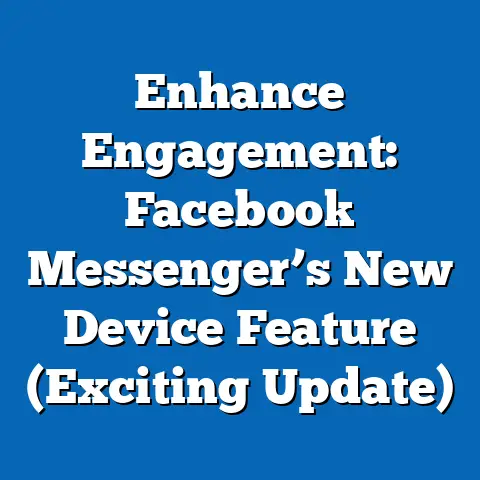Maximize ROI with Facebook Ad Overlap (Strategic Insights)
In the rapidly evolving landscape of digital marketing, achieving a high return on investment (ROI) through targeted advertising is a critical goal for businesses. Among the myriad platforms available, Facebook remains a dominant force, offering unparalleled reach and sophisticated targeting options. One advanced strategy that has gained traction among marketers is leveraging ad overlap—a technique that intentionally targets overlapping audience segments to maximize exposure and engagement while optimizing costs.
While ad overlap strategies are often applied broadly, this article narrows its focus to advertising campaigns targeting children, a demographic with unique characteristics, legal considerations, and societal implications. By understanding the nuances of this group, marketers can craft campaigns that not only maximize ROI but also align with ethical standards and regulatory frameworks. This comprehensive analysis will explore the defining characteristics of children as a target audience, the historical context shaping their media consumption, the societal implications of advertising to them, and how Facebook ad overlap can be strategically implemented to achieve marketing goals.
Part 1: Understanding Children as a Target Audience
Defining Characteristics of Children
For the purposes of this analysis, “children” are defined as individuals under the age of 13, aligning with legal frameworks such as the Children’s Online Privacy Protection Act (COPPA) in the United States. This age group is characterized by a limited capacity for critical thinking and decision-making, making them particularly impressionable to advertising messages. Their cognitive development stages mean they often lack the ability to distinguish between commercial intent and entertainment, which can influence their perceptions and behaviors in unique ways.
Children are also highly influenced by peer groups and family dynamics, often relying on parents or guardians for purchasing decisions. However, their role as “influencers” within the family unit cannot be underestimated, as they frequently drive demand for products ranging from toys to snacks. Additionally, children today are digital natives, growing up with technology as an integral part of their lives, which shapes their media consumption patterns and responsiveness to online advertising.
Historical Context: Shaping Media Consumption Among Children
The relationship between children and media has evolved dramatically over the past century, influenced by technological advancements and societal shifts. In the mid-20th century, television emerged as the dominant medium for reaching young audiences, with advertisers creating iconic campaigns for cereals, toys, and other child-oriented products. Regulatory measures, such as the establishment of the Federal Communications Commission (FCC) guidelines in the 1970s, sought to limit the exploitative nature of advertising to children by restricting the amount of commercial content during children’s programming.
The advent of the internet in the late 1990s and early 2000s marked a seismic shift in how children engage with media. Platforms like YouTube, social media, and mobile apps have become central to their daily lives, with studies indicating that children aged 8-12 spend an average of 4-6 hours per day on digital devices (Common Sense Media, 2021). This digital immersion has made online advertising, particularly on platforms like Facebook (through parent-targeted campaigns or family-oriented content), a critical channel for reaching this demographic indirectly.
Significant events, such as the implementation of COPPA in 1998, have shaped the legal and ethical boundaries of digital advertising to children. COPPA mandates strict guidelines on data collection and privacy for users under 13, requiring parental consent and limiting how personal information can be used. These regulations have forced marketers to adapt, often targeting parents as proxies while still crafting messages that resonate with younger audiences.
Societal Implications of Advertising to Children
Advertising to children carries profound societal implications, influencing everything from consumer behavior to cultural norms. On one hand, marketing can play a positive role by promoting educational products, healthy lifestyles, and creativity through toys or interactive content. On the other hand, critics argue that excessive advertising contributes to materialism, unhealthy eating habits (e.g., through fast food promotions), and unrealistic body image standards among children.
The ethical debate surrounding advertising to children is particularly pronounced in the digital age, where targeted ads can exploit vulnerabilities through personalized messaging. For instance, the use of gamification and influencer marketing on platforms frequented by children can blur the lines between content and commerce, raising concerns about manipulation. A 2019 study by the American Psychological Association highlighted that children exposed to high levels of advertising are more likely to exhibit consumerist attitudes and experience dissatisfaction with their own possessions.
Moreover, the role of parents as gatekeepers adds another layer of complexity. While children may be the end consumers, parents often control purchasing decisions and are increasingly wary of privacy invasions and inappropriate content. This dynamic necessitates a dual-targeting approach in advertising, where campaigns must appeal to both children’s desires and parents’ values—a challenge that Facebook ad overlap strategies can address effectively.
Part 2: The Mechanics of Facebook Ad Overlap
What is Ad Overlap and Why Does It Matter?
Facebook ad overlap refers to the practice of running multiple ad sets or campaigns that target overlapping audience segments, either intentionally or unintentionally. When done strategically, overlap can amplify reach and frequency, ensuring that key messages are seen multiple times by the same users, which can enhance brand recall and conversion rates. However, if not managed properly, overlap can lead to audience fatigue, increased costs, and diminished ROI due to redundant impressions.
In the context of targeting children, ad overlap must be approached with caution due to the ethical and legal constraints surrounding this demographic. Since direct targeting of children under 13 is restricted on Facebook, marketers often focus on parents, family-oriented groups, or broader demographics while embedding child-friendly messaging. Overlap strategies can help ensure that these messages are seen by the right parental audience segments across different ad sets, maximizing the likelihood of influencing family purchasing decisions.
Strategic Benefits of Ad Overlap for Child-Centric Campaigns
-
Enhanced Frequency and Reinforcement: By overlapping ad sets targeting parents of young children (e.g., through interest-based targeting for parenting groups and demographic targeting for specific age ranges), marketers can reinforce messaging about child-oriented products. Studies show that repeated exposure increases brand familiarity, with a 2020 Nielsen report indicating that frequency can boost purchase intent by up to 20% in family-oriented campaigns.
-
Cost Efficiency: Overlap, when managed with tools like Facebook’s Audience Overlap feature, allows marketers to identify and consolidate redundant audiences, reducing wasted ad spend. For instance, combining audiences interested in children’s toys and family activities into a unified campaign can lower cost-per-impression (CPM) while maintaining reach.
-
Cross-Channel Synergy: Overlap strategies can extend beyond Facebook to include Instagram (owned by Meta), where family-oriented content often resonates through visual storytelling. By aligning overlapping audiences across platforms, marketers can create a cohesive narrative that appeals to both parents and, indirectly, children.
-
Personalization and Relevance: Overlapping ad sets with tailored creative content (e.g., ads for educational toys versus entertainment products) ensures that messages remain relevant to diverse parental needs within the same demographic. This customization can drive higher engagement rates, with Meta’s 2021 data suggesting that personalized ads achieve 40% higher click-through rates (CTR).
Challenges and Pitfalls to Avoid
Despite its benefits, ad overlap poses several challenges, particularly when targeting family audiences with child-centric messaging. Audience fatigue is a significant risk, as parents may feel overwhelmed by repetitive ads, leading to negative brand perceptions. A 2022 survey by eMarketer found that 65% of parents reported annoyance with overly frequent ads for children’s products, highlighting the need for balanced frequency caps.
Additionally, privacy concerns are paramount. Overlapping audiences often involves leveraging detailed behavioral and interest data, which can raise red flags under regulations like COPPA and the General Data Protection Regulation (GDPR). Marketers must ensure compliance by anonymizing data and obtaining explicit consent where required, even when targeting adults on behalf of children.
Finally, there is the risk of unintended overlap, where ad sets compete against each other, driving up costs through internal bidding wars within Facebook’s ad auction system. Tools like Facebook’s Ad Manager can help diagnose and mitigate this issue, ensuring that overlap is strategic rather than accidental.
Part 3: Implementing Ad Overlap Strategies for Child-Oriented Campaigns
Step 1: Audience Segmentation with a Family Focus
Effective ad overlap begins with precise audience segmentation. Since direct targeting of children is restricted, marketers should focus on parents and caregivers, using demographic filters such as age (e.g., 25-45 years old), parental status, and geographic location. Interest-based targeting can further refine audiences by focusing on behaviors like engagement with parenting pages, children’s entertainment, or educational content.
For overlap to work, marketers can create multiple ad sets within these segments. For example, one ad set might target parents interested in educational toys, while another targets those engaged with family entertainment. By overlapping these groups, the campaign ensures broader coverage while maintaining relevance to child-centric needs.
Step 2: Crafting Dual-Appeal Creative Content
Creative content is the cornerstone of any successful ad campaign, especially when targeting families. Ads must appeal to parents’ practical concerns (e.g., affordability, safety, educational value) while subtly incorporating elements that resonate with children (e.g., bright colors, playful themes). Overlapping ad sets can test different creative approaches—such as video ads versus static images—to determine which formats drive the highest engagement.
A 2021 study by Kantar Media found that family-oriented ads with emotional storytelling (e.g., showing parent-child bonding) outperform purely transactional ads by 30% in terms of brand favorability. Marketers should leverage such insights to create content that speaks to both decision-makers and end-users within the family unit.
Step 3: Optimizing Frequency and Reach
Balancing frequency and reach is critical in overlap strategies to avoid audience fatigue. Facebook’s ad platform allows marketers to set frequency caps, ensuring that users see ads a limited number of times within a specified period. For child-oriented campaigns, a frequency of 3-5 impressions per week per user is often ideal, based on industry benchmarks from WordStream (2022), as it maintains visibility without overwhelming parents.
Additionally, using reach optimization tools can help expand the campaign’s footprint within overlapping segments, ensuring that messages penetrate diverse family demographics. This approach is particularly effective for seasonal campaigns, such as holiday toy promotions, where timely exposure is crucial.
Step 4: Measuring and Adjusting Performance
Continuous monitoring is essential to maximize ROI with ad overlap. Key performance indicators (KPIs) such as CTR, conversion rate, and cost-per-acquisition (CPA) provide insights into campaign effectiveness. Facebook’s Insights tool can also reveal overlap percentages between ad sets, allowing marketers to adjust targeting parameters to minimize redundancy.
A/B testing different overlap configurations—such as varying audience sizes or creative formats—can further refine strategies. For instance, a campaign targeting parents of preschoolers might test whether a 50% overlap between two ad sets yields better results than a 30% overlap, using data-driven decisions to optimize spend.
Part 4: Ethical and Legal Considerations in Targeting Families
Navigating Regulatory Frameworks
Compliance with legal standards is non-negotiable when advertising products aimed at children, even indirectly through parents. In the U.S., COPPA imposes strict rules on data collection for users under 13, requiring verifiable parental consent and limiting the use of personal information. The GDPR in Europe extends similar protections, emphasizing transparency and user rights.
Marketers using ad overlap must ensure that targeting data is aggregated and anonymized to prevent privacy violations. Partnering with legal experts or using Meta’s built-in compliance tools can help navigate these complex regulations, safeguarding both the brand and its audience.
Ethical Marketing Practices
Beyond legal requirements, ethical considerations play a crucial role in shaping public perception. Marketers should avoid exploitative tactics, such as using overly manipulative language or promoting unhealthy products to impressionable audiences. Instead, campaigns should prioritize value-driven messaging, focusing on how products enhance family life or support child development.
Transparency is also key. Disclosing sponsored content and clearly labeling ads as commercial material builds trust with parents, who are increasingly savvy about digital marketing tactics. A 2020 Pew Research Center survey found that 72% of parents value brands that demonstrate ethical advertising practices, underscoring the importance of integrity in child-centric campaigns.
Part 5: Broader Implications for Society and Business
Societal Impact of Digital Advertising to Families
The pervasive nature of digital advertising, amplified by strategies like ad overlap, has far-reaching implications for societal norms around consumption and family dynamics. On one hand, targeted campaigns can empower parents with information about products that meet their children’s needs, from educational tools to safety gear. On the other hand, the constant barrage of ads can exacerbate consumerism, placing pressure on families to keep up with trends and peer expectations.
Moreover, the digital divide remains a concern. Not all families have equal access to technology or the digital literacy to navigate online ads critically. This disparity can widen socioeconomic gaps, as children from lower-income households may feel excluded from marketed lifestyles, while those from affluent backgrounds face overexposure to commercial messages.
Workplace and Marketing Industry Trends
For businesses, mastering ad overlap and child-centric targeting can provide a competitive edge in a crowded marketplace. As family-oriented products continue to dominate sectors like toys (a $100 billion global industry, per Statista 2023), education, and entertainment, marketers who balance ROI with ethical considerations will likely build stronger brand loyalty. This trend is already evident in the rise of purpose-driven marketing, where companies align with family values to differentiate themselves.
In the workplace, the focus on digital strategies like ad overlap underscores the need for upskilling in data analytics and compliance. Marketing teams must be equipped to handle sophisticated tools while adhering to evolving regulations, a challenge that may reshape hiring and training priorities in the coming years.
Conclusion: Forward-Looking Insights
Maximizing ROI with Facebook ad overlap offers a powerful opportunity for marketers targeting family audiences with child-centric messaging. By strategically overlapping audience segments, businesses can enhance reach, reinforce brand messaging, and optimize costs—key drivers of successful campaigns. However, the unique characteristics of children as an indirect audience, coupled with legal and ethical constraints, demand a nuanced approach that prioritizes compliance and societal impact.
Looking ahead, the intersection of technology and regulation will continue to shape how marketers engage with family demographics. Advances in artificial intelligence and machine learning may enable even more precise targeting, while stricter privacy laws could impose new limitations. The challenge for marketers will be to adapt to these uncertainties while maintaining a commitment to ethical practices that protect vulnerable audiences.
Ultimately, the success of ad overlap strategies lies in balancing profitability with responsibility. By understanding the historical and societal context of advertising to children, leveraging data-driven tactics, and anticipating future trends, businesses can create campaigns that not only maximize ROI but also contribute positively to the cultural landscape. As the digital marketing ecosystem evolves, this dual focus will be the cornerstone of sustainable growth in child-oriented advertising.






